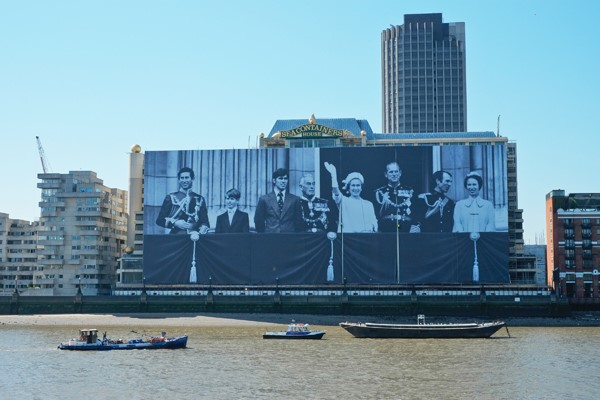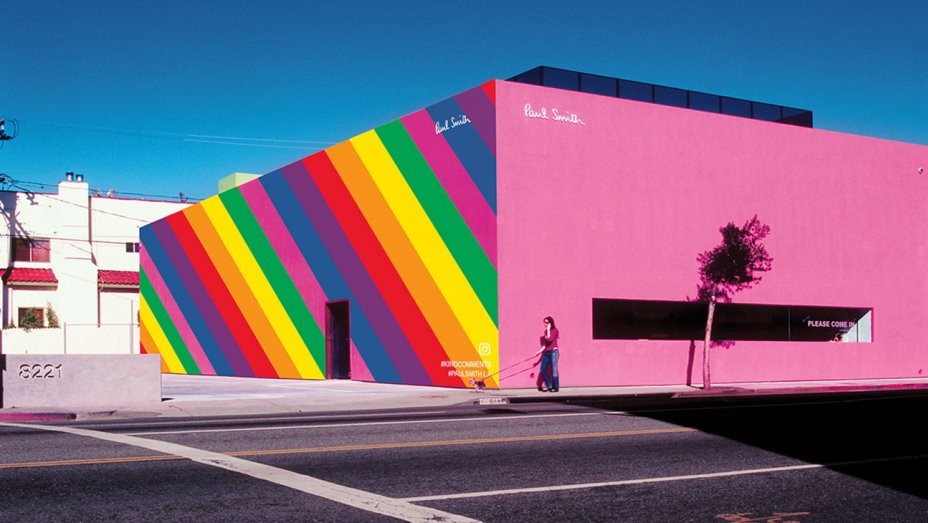Dream big

Imagining the opportunities available to a building site requires a creative approach to signage and brand touchpoints. Ruth Wyatt explores best practice in creative hoardings and signage design
In 2012, Sea Containers House on the south bank of the River Thames was a vast construction site, destined to be a high end mixed-use development. Golden Goose PR was hired to promote it to potential tenants when founder Miki Haines-Sanger had a flash of inspiration. Wrap the building in an iconic shot of the British royal family celebrating Queen Elizabeth II’s silver jubilee.
As the Queen’s diamond jubilee flotilla had to sail past it down the river, the royal family and all the world’s media covering the event had to see it. You literally could not escape it. It was 100m high. And it was a stroke of genius. The photocall for the unveiling of the poster achieved front page coverage across national press and exposure in international press.
On the day of celebration, the name Sea Containers House received mass media coverage and the black and white photo became one of the defining images of the summer. A multinational ad agency took out a lease shortly afterwards. Others followed. All for less than £120,000.
Boom.
Golden Goose brought building wraps to the world creative stage when it won a richly deserved gold PR Lion at the Cannes Festival of Creativity in 2013. Tickling a creative’s fancy is never a bad thing. And rather than seeing ugly building sites as an eyesore, viewing them as a giant canvas opens all sorts of creative possibilities. It’s free advertising. It’s a different way of thinking: property as media.
It’s a little-known fact that Shell, the petrochemical and roadside service station giant, is technically one of the UK’s largest media owners. All the signage leading up to, outside and inside service stations adds up to a huge amount of advertising space.
Take this idea of buildings as owned media and apply creativity to it, suddenly there is a hugely impactful addition to a brand’s communications portfolio. Building wraps are potent weapons in the right hands, as a quick look at the Louis Vuitton playbook attests.
Take Virgil Abloh’s 12-storey holographic mannequin staring down New York’s skyscrapers from the brand’s Fifth Avenue boutique. Talk about standout promotion. The technicolour spectacle provided an unmissable piece of promotion for Abloh’s spring/summer 2019 menswear collection for Louis Vuitton. The same space has been used to highlight collaborations with artists, such as renowned polka dot obsessive Yayoi Kusama and Takashi Murakami, whose signature multicoloured monogram print adorned the building to great effect.
In late 2019, Louis Vuitton unveiled its renovated London store in New Bond Street in typical fashion. Having used building wraps through much of the reconstruction for both general brand marketing and site-specific communication, when the time came to throw open the doors, it festooned the shopfront with a 3D technicolour explosion like a firework frozen in time. Wham. The Day-Glo artwork had an immediate impact and made the shop the most Instagrammable retail outlet in the UK overnight.
Admittedly, Louis Vuitton has a large and dedicated international team of creatives, but many companies with fewer resources use building wraps and hoardings to magnificent effect. And the benefits are far from limited to free advertising space as sign manufacturer Lavastar’s director Ed Kelsing points out. “There are loads of benefits. Yes, it’s a marketing tool that, unlike a billboard, can be seen from miles away, and it makes construction sites much more discreet and visually appealing. With CGI you can show what the building will look like to generate interest and make it an attractive part of the landscape. But, a wrap also reduces noise and dust pollution for those around the site and can help to protect it from harsh weather,” he says.
Nikki Burton, creative director of London-based creative agency Perq Studio agrees, “It’s worth noting that building sites often cause disruption and can make people grumpy, so playful, emotive messaging could be a real mood-changer when messaging tantalises, sparks curiosity and makes people want to find out more. Hoarding provides the perfect opportunity to tell people what your brand is all about, at a huge (and unmissable), hyper-local scale. This is a real opportunity to drive relevance within your brand message and you can use a long string of hoarding to tell multiple stories, layering creative to build up to a bigger brand picture.”
“Building sites often cause disruption and can make people grumpy, so playful, emotive messaging could be a real mood-changer when messaging tantalises, sparks curiosity and makes people want to find out more”

Building wraps can even replace building sites on occasion. Lavastar worked with Spanish jewellery business Tenerife Perla earlier this year on what turned out to be an award-winning installation.
The render on the building was cracking and would’ve cost £40,000 to repair. The company “stumbled across” Lavastar on Instragram and soon after commissioned it to wrap the entire building as a permanent alternative. Lavastar installed over 300m of aluminium frame around the perimeter of each face of the building to hold tensioned banners carrying eye-catching graphics that promoted the business so beautifully that soon people were stopping to take pictures of it. Better yet, the total cost was a mere £26,000 and Tenerife Perla has the option to update the wrap in the future for around £15,000 to keep its look fresh and appealing.
Wraps and hoardings are nothing if not adaptable and can evolve with the site they embellish, but preparation is vital. Aside from what can be as long as an eight-week waiting period for planning permission that Kelsing mentions, Burton says, “You need to make sure you walk the site to understand where the hoarding line can go, and also accept that this line will move throughout construction, so get ready to refresh your creative or think of modular ways to approach this.
She adds, “Make sure you understand how people will experience the hoarding – on foot? By bus? Car? What are the main directions of travel? A good understanding of the customer journey is key to making sure you balance brand and directional messaging. Once you know this, let your creativity flow, and if budgets allow, explore different materials, textures and layers to make sure you stand out. Any form of illumination is spot on for these dreary winter months too.”
These were key considerations in Perq’s work for Ballymore on its Goodluck Hope property development in London. Perq’s task was to use hoarding to direct people from public transport to the development, which the design agency saw as a perfect opportunity to bring to life the brand message and cultural heritage of the development with a fly-poster effect that told the stories of the creative community in the area. It was supported with playful floor graphics as an important consideration is to realise hoarding can’t do everything by itself.
Kelsing says that projects can run from 5m by 5m shopfronts to 4,000 square metres, from £1,000 to £120,000 and from a lifespan of a few weeks to three years or even longer in the case of Tenerife Perla. They can be playful, engaging, unmissable or deliberately recessive to the point of being virtually invisible so they blend into the immediate environment.
There are few limits on what can be done in terms of logistics. An assault on the senses or subtle brand messaging or anywhere in between; the choice is for those who dare to dream.












